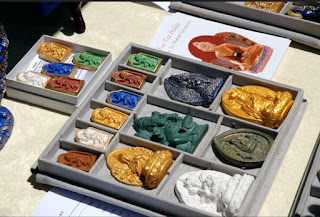The Art Of Boxes
"The Art of Boxes" is one name for the technical system of taking Tibetan text material and finding the relationships between nouns and verbs, between case particles, quotation marks, and other known constructs. And then you draw boxes around these on the paper, or mentally in your mind. This helps you see the bigger picture -- after a while mentally you could do this and at some point it's natural to find and translate in your head all the parts that work together. You could even draw nested boxes as written Tibetan could have sections of a subsection of a subsection....
Craig Preston's How To Read Classical Tibetan Volume 1 and Volume 2 books uses this concept when teaching Tibetan translation. I will actually use here Frances Garret's "Sentence Building The Life of Milarepa Chapter 1 video" from her series of videos how to translate Tibetan sentences from her excellent Frances Garret Classical Tibetan YouTube channel. And instead of boxes I will use font colorization.
The first sentence looks like this:
༡༽ རས་ཆུང་པས་རྗེ་བཙུན་ལ་ཁྱེད་རང་གི་མཛད་རྣམ་གསུང་དུ་གསོལ་ཞེས་གསོལ་བ་བཏབ།
If we do a quick scan of particles we will find ས་ agent particle of the ending པས་, ལ་ , a གི་ genitive or six case, an a དུ་ . The ཞེས་ is a syntactic particle that marks the end of a quote, or ". Tibetan does not use a starting quote particle so we need to find the starting point earlier in the sentence.
Verbs are at the end of a sentence (not necessary always at the end of a། ) and nouns are in the beginning. We scan for verbs and find the final verb གསོལ་བ་བཏབ་ , a compound verb that means ask for a request. Another compound verb before this one is གསུང་དུ་གསོལ་ please speak as དུ་གསོལ་ is a pattern for please do and the preceding verb གསུང་ is the honorific for to speak.
Next we look for vocabulary for nouns, names and other patterns (you could, of course, also start with this first).
༡༽ རས་ཆུང་པས་རྗེ་བཙུན་ལ་ཁྱེད་རང་གི་མཛད་རྣམ་གསུང་དུ་གསོལ་ཞེས་གསོལ་བ་བཏབ།
རས་ཆུང་པ་ is Rechunpa, a famous student of... རྗེ་བཙུན་ Jetsun where this text is referring to Jetsun Milarepa. ་ཁྱེད་རང་ means 'you', མཛད་རྣམ་ is biography or life story, where མཛད་ is a honorific for for 'doing' or the act of doing a life story.
༡༽ རས་ཆུང་པས་རྗེ་བཙུན་ལ་ཁྱེད་རང་གི་མཛད་རྣམ་གསུང་དུ་གསོལ་ཞེས་གསོལ་བ་བཏབ།
Using the case markers and known words, we could translate རས་ཆུང་པས་རྗེ་བཙུན་ལ་ as by Rechungpa (agent doing something) to Jetsun. Using the final verb གསོལ་བ་བཏབ། (subject-object-verb) with a quotation following this part, we have Rechungpa made a request to Jetsun Milarepa:
The quote starts then with ཁྱེད་རང་. ཁྱེད་རང་གི་མཛད་རྣམ is your biography. གསུང་དུ་གསོལ་, please tell it.
A possible translation is: Rechungpa made a request to Jetsun Milarepa: "Please tell us your biography".
You could check all the other word translation videos at Frances Garret's YouTube channel and get a good understanding how this also works with long and complex sentences.
To recap: it becomes easier the more words, compound words, dharma terms, names and so forth you recognize. If you know the particle system and how they bind constructs you could see the connections. The more verbs and compound verbs you recognize the better. It also helps to look at existing translations, over and over. This way you will quickly get used to quickly recognize the patterns and how they work together.

